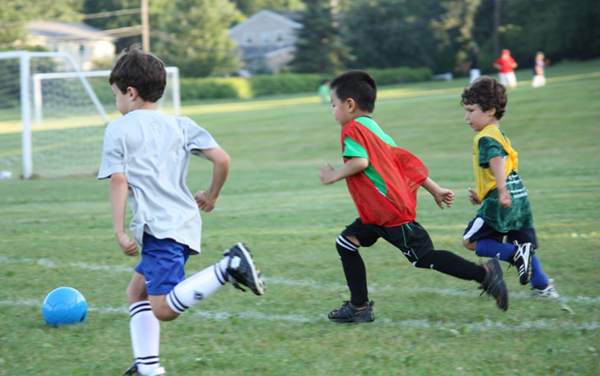(单词翻译:单击)
GWEN IFILL: A new initiative designed to make soccer safer for young players was just announced by the U.S. Soccer Federation. The new rule would set limits on how much players could use their heads to physically hit the ball. The hope is that it would reduce the number of concussions and head injuries.
William Brangham has more on the changes and the emerging science behind them.
WILLIAM BRANGHAM: Today, soccer is one of the leading causes of concussions for young athletes in the U.S. It's not as high as the concussion rate for football, but it's close. Tens of thousands of kids get concussions playing soccer every year, and heading the ball is considered a main culprit.
Under U.S. soccer's new rules, kids under the age of 10 won't be heading the ball at all. Kids aged 11-13 will head the ball much less in practice. And there will be new rules on injury substitutions during games. Players 14 and up will continue heading as always.

These new rules will resolve a lawsuit brought last year against U.S. soccer and others by a group of parents in California who argued the groups weren't doing enough to protect kids from head injuries. Last year, we reported on the rising concern over concussions in soccer and the push to limit heading for young players.
Back then, I talked with one of the leading scientists in the field, Dr. Robert Cantu. He's a neurosurgeon and co-directs a brain study center at Boston University. Cantu acknowledged that the science connecting soccer and brain injury was limited. He's in fact called for much more research to be done.
But, even so, he's argued that it's better to be safe and not allow young kids to repeatedly head the ball.
DR. ROBERT CANTU, Concussion Legacy Foundation: If you took heading out of soccer, it wouldn't be behind football in the incidence of concussion. It wouldn't even be in the high-risk group. It would be in a low-risk group.
WILLIAM BRANGHAM: Cantu told me that heading the ball, as well as the collisions and hard falls to the ground they often cause, are problematic for kids, because, unlike adult brains, kids' brains are still developing.
DR. ROBERT CANTU: The young brain is largely not myelinated. Myelin is the coating of nerve fibers that connect nerve cells. Similar to coating on a telephone wire, it helps transmission but it also gives strength.
And so when you violently shake the young brain, you have a much greater chance to disrupt nerve fibers and their connections than you do an adult brain.
WILLIAM BRANGHAM: Cantu says a kids heads also sit on a much less developed neck and torso than an adult's does, so the same blow might cause more shaking to a kid's head than it would to a grownup's.
DR. ROBERT CANTU: So, you've got a bobblehead doll effect with our youngsters, so that the very minimal impact is now going to set their brain in much more motion than it would in an adult brain with a strong neck.
WILLIAM BRANGHAM: Cantu says strengthening a kid's neck muscles can help, but those soccer helmets and headgear that you see on the market don't really offer much protection, so he says there's only one thing left to do.
DR. ROBERT CANTU: Take the most injurious activity for head injury out of it, but let the rest of the sport go on. And that's playing soccer without heading.
WILLIAM BRANGHAM: You can watch the full report on our Web site, PBS.org/NewsHour. You can also read a longer interview with Dr. Cantu about concussions in youth sports.


